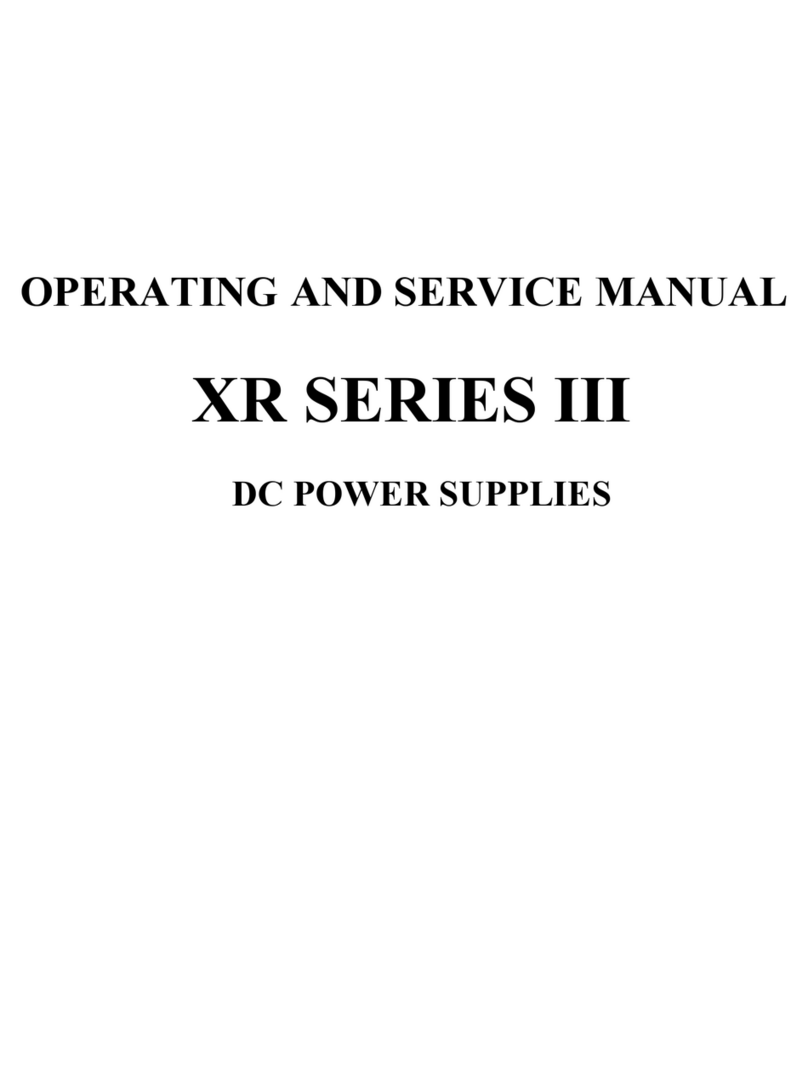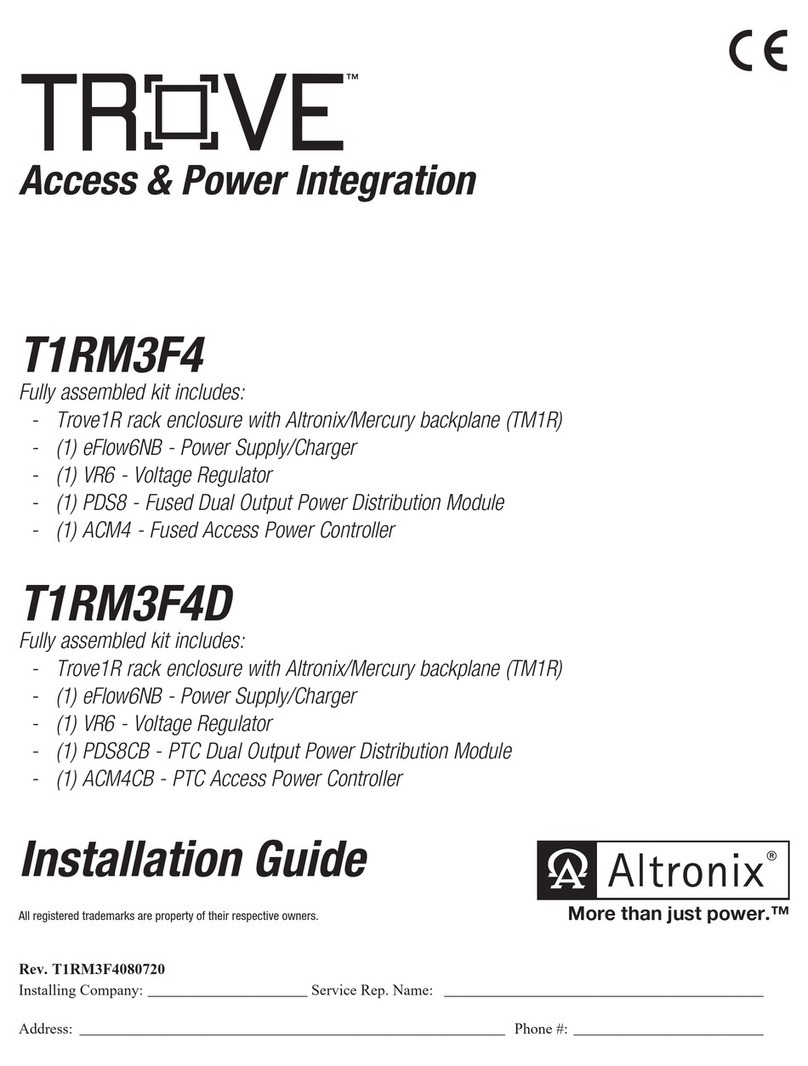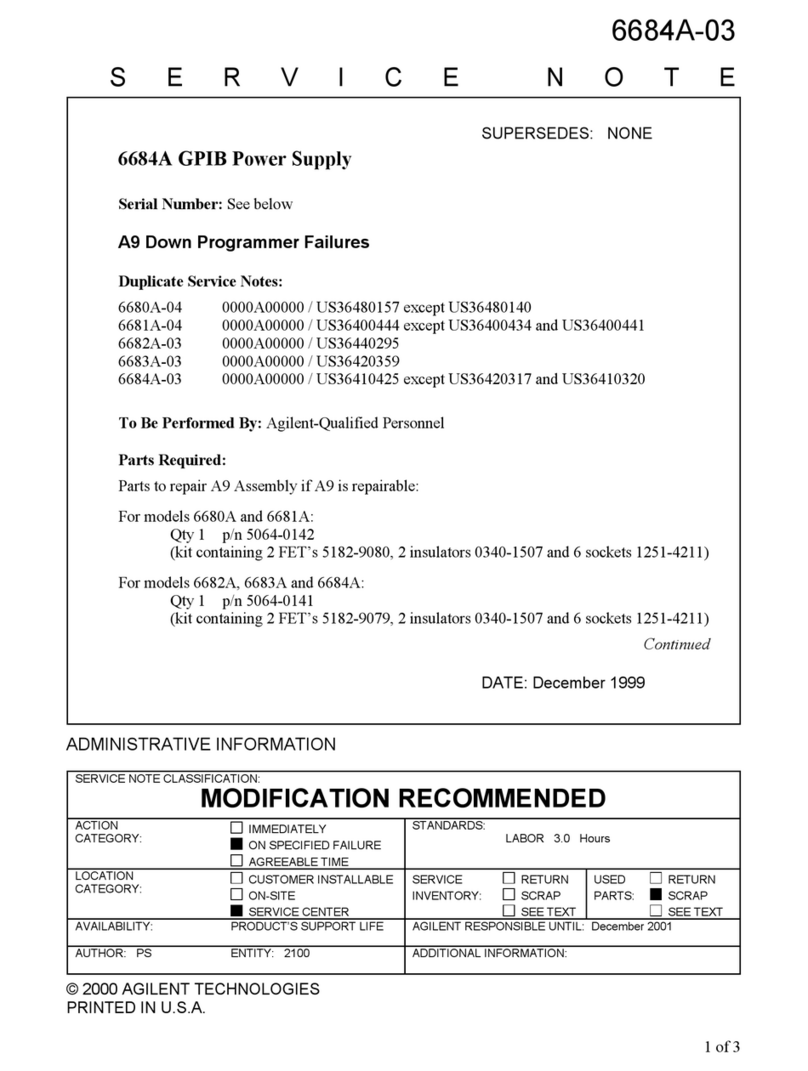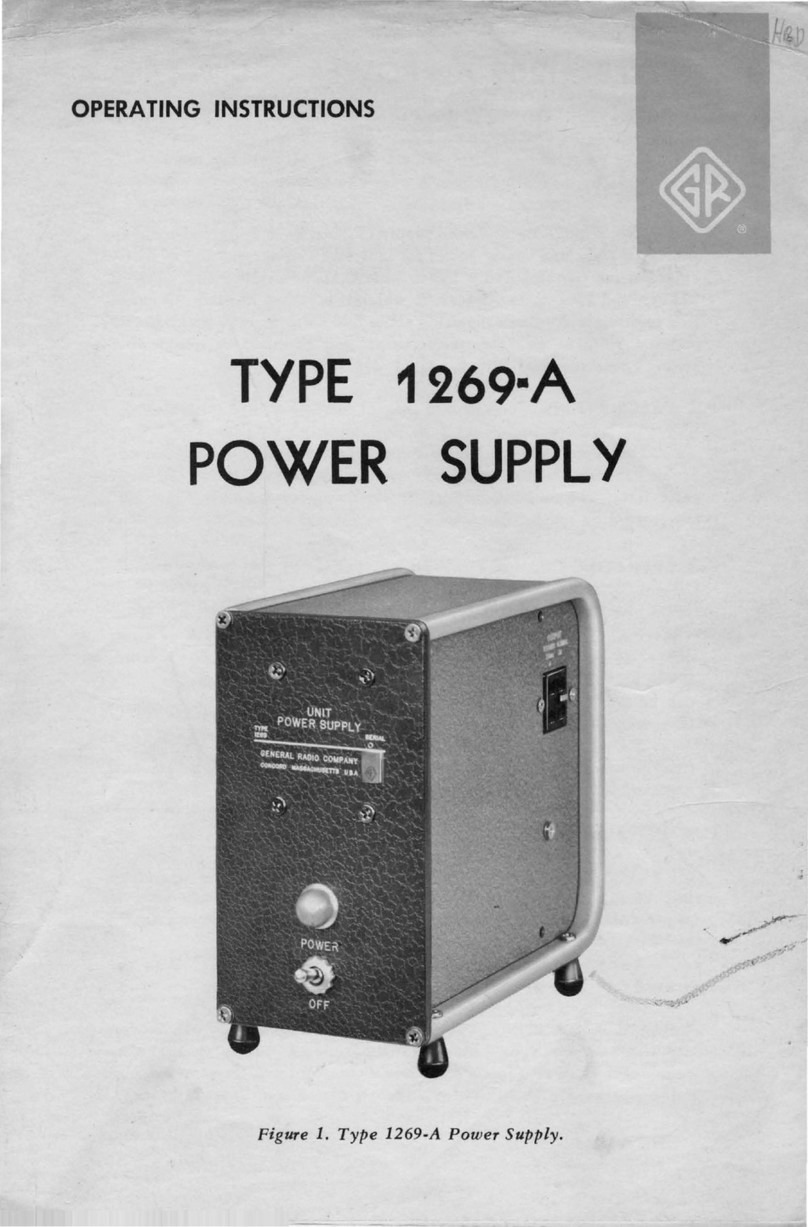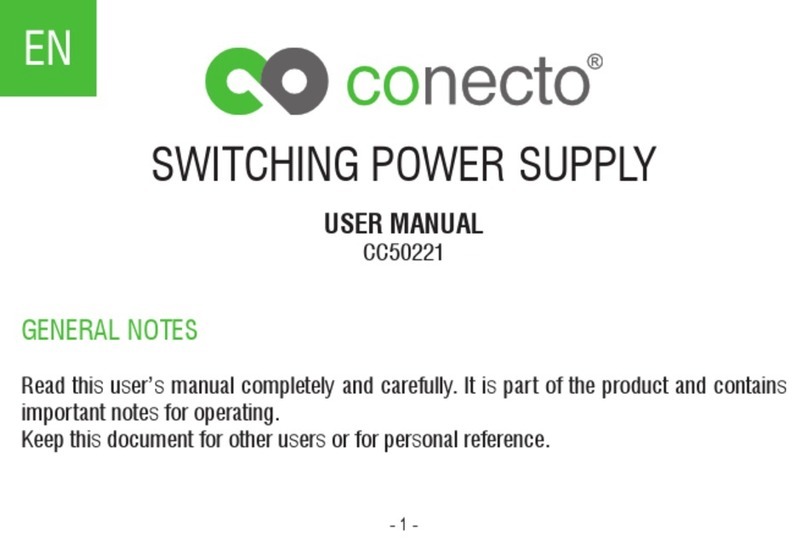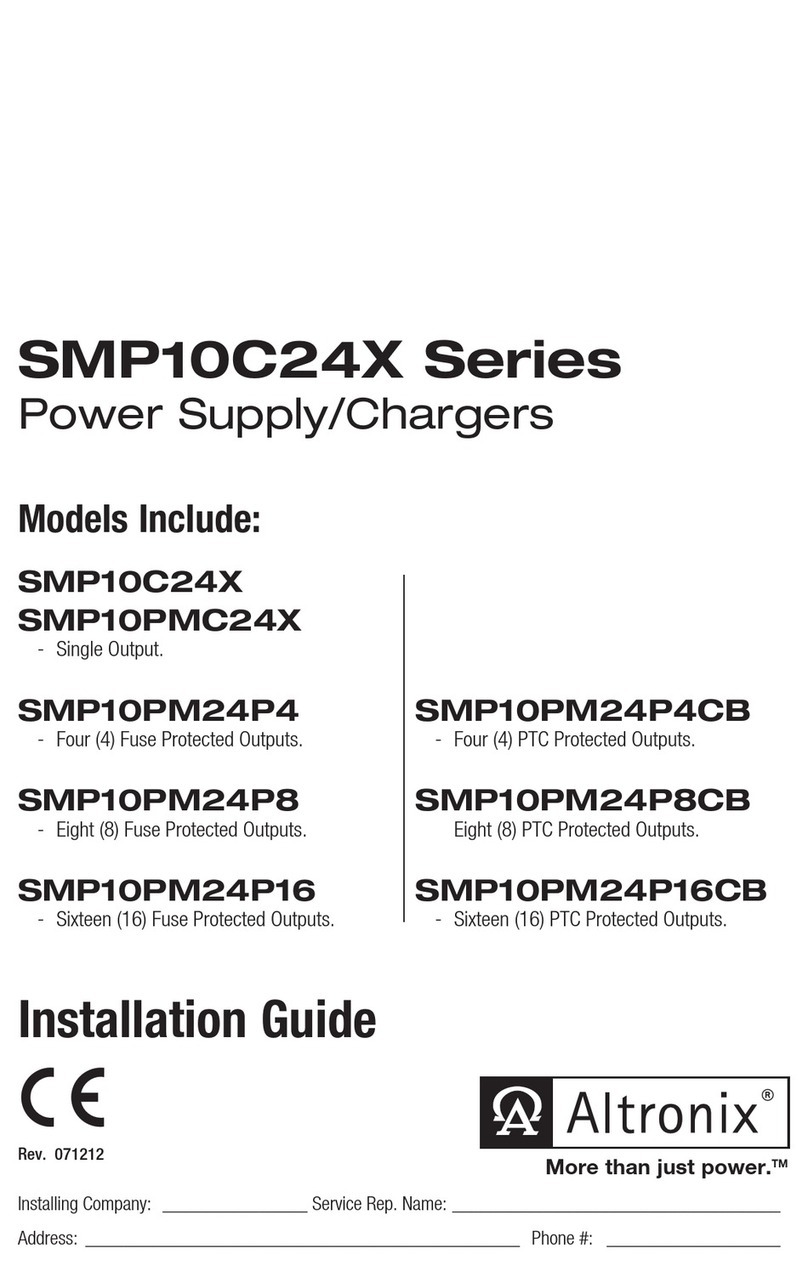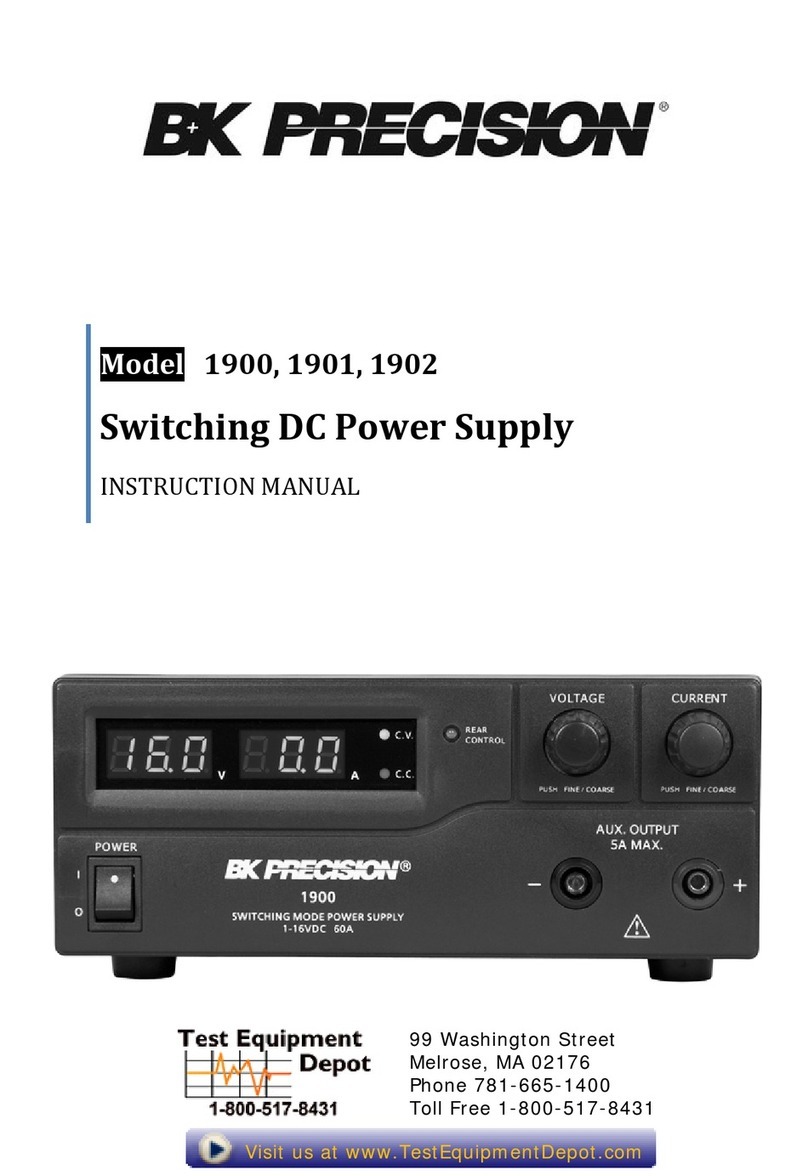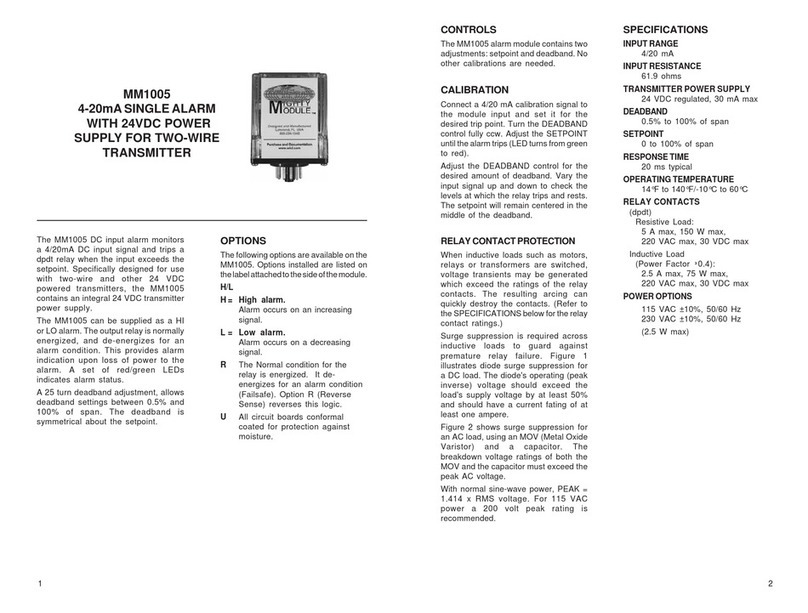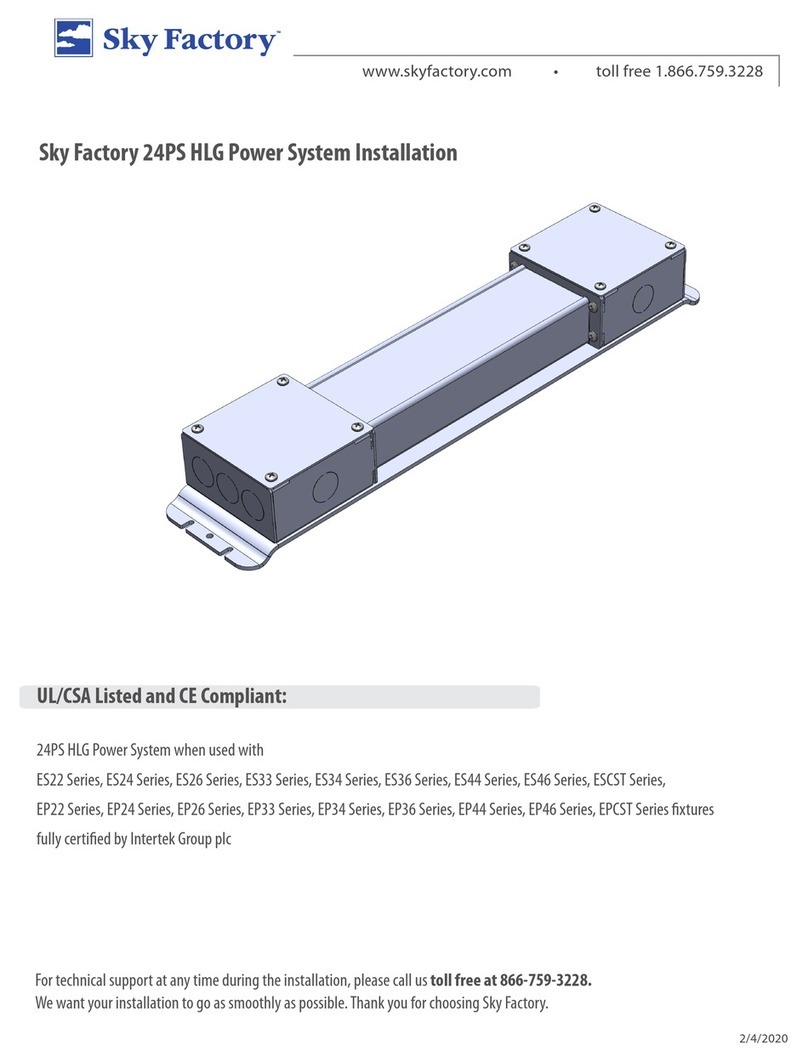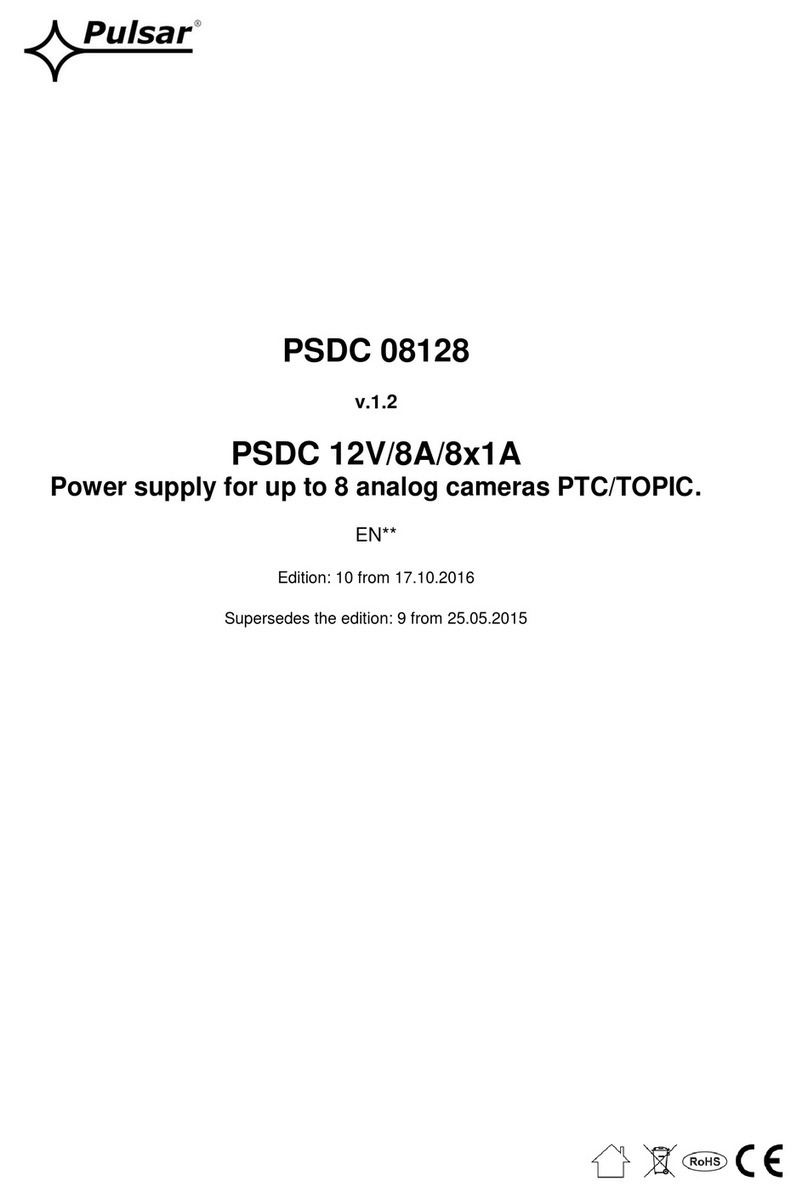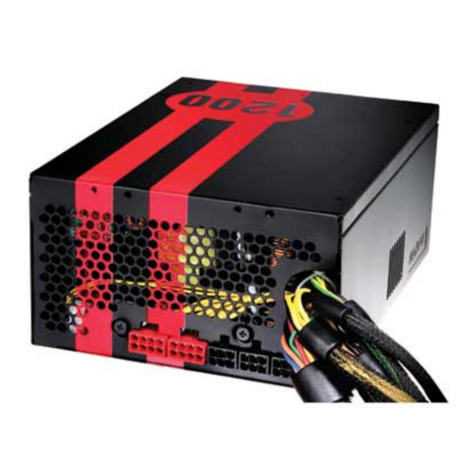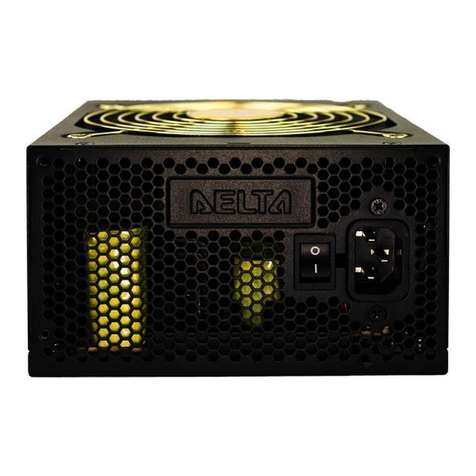MPE DP SERIES II Service manual

OPERATING AND SERVICE MANUAL
DP SERIES II
DC POWER SUPPLIES


MAGNA-POWER ELECTRONICS, INC.
39 ROYAL ROAD, FLEMINGTON, NJ 08822
January 6, 2010


SAFETY NOTICE
Before applying power to the system, verify that the unit is configured properly for the user’s
particular application.
CE recognition of DP Series power supplies is based on rack mounted applications only. Use of
these power supplies outside of a rack mount equipment enclosure will expose the user to high
voltage and/or high current sources. Extreme caution must be used under these circumstances.
Two or more DP Series power supplies may be connected in series. For models rated 1000 V or
less and regardless of the number of units or the voltage ratings of the series connected power
supplies, the voltage potential from any output terminal to chassis ground should not exceed
1000 Vdc. For models rated greater that 1000 V and regardless of the number of units or the
voltage ratings of the series connected power supplies, the voltage potential from any output
terminal to chassis ground should not exceed 4000 Vdc.
Installation and service must be performed only by properly trained and qualified personnel who
are aware of dealing with electrical hazards. Ensure that the ac power line ground is properly
connected to the power supply chassis. Furthermore, other power grounds, including those
connected to application maintenance equipment, must be grounded for both personnel and
equipment safety.
Always ensure that facility ac input power is de-energized prior to connecting or disconnecting
the input and output power cables.
Caution: Lethal voltages may be present inside the power supply even when the
ac input voltage is disconnected. Only properly trained and qualified personnel
should remove covers and access the inside of the power supply.
During normal operation, the operator does not have access to hazardous voltages within the
cabinet. Depending on the user’s application, high voltages hazardous to human safety may be
generated normally on the output terminals. Ensure that the output power cables are properly
labeled as to the safety hazards and that any inadvertent contact with hazardous voltages is
eliminated.
This power supply is designed to be permanently connected to the power source requiring a
readily accessible disconnect device incorporated in the fixed wiring.
These operating instructions form an integral part of the equipment and must be available to the
operating personnel at all times. All the safety instructions and advice notes are to be followed.
Neither Magna-Power Electronics, Inc. nor any of the associated sales organizations can accept
responsibility for personal injury, consequential injury, loss, or damage that results from
i

improper use of the equipment and accessories.
ii

LIMITED WARRANTY
The following is made in lieu of all warranties expressed or implied.
Magna-Power Electronics, Inc. warranties its products to be free of manufacturing defects for a
period of two (2) years from date of original shipment from its factory. Magna-Power
Electronics, Inc. will repair, replace, or refund the purchase price at its discretion, which upon
examination by Magna-Power Electronics, Inc., is determined to be defective in material or
workmanship, providing such claimed defective material is returned upon written authorization
of Magna-Power Electronics, Inc., freight prepaid.
For products failing within the first 30 days of the warranty period, Magna-Power Electronics,
Inc. will return the repaired product at its expense using a standard shipping method; after 30
days of the warranty period, the repaired product will be returned at the customer’s expense
using the customer’s requested shipping method.
Damage due to corrosion, customer alterations, excessive dust, extreme environmental or
electrical conditions, and/or misuse will be evaluated upon inspection. If inspection reveals that
the cause of damage is not due to materials or workmanship, repair of the product will be treated
on a non-warranty basis.
All electrical, commercial supply parts, and items not manufactured by Magna-Power
Electronics, Inc. shall carry the warranty of the original manufacturer and no more, but under no
circumstances to exceed the warranty period. Replacement parts shall be warranted for a period
of 90 days.
Warranty labor shall only apply if the product, assembly, or part is returned to the factory freight
prepaid and insured. Damage or breakage while in transit is not covered by this warranty.
Magna-Power Electronics, Inc. assumes no responsibility to Buyer for labor to diagnose and
remove defective product and installation of replacement product. Furthermore, Magna-Power
Electronics, Inc. is not liable to Buyer or to any third party for consequential or incidental
damages under any circumstances, whether due to defect in the product, due to delay or failure
of delivery, due to a failure of the product to perform as specified, or for any other reason or
cause. Buyer and Magna-Power Electronics, Inc. agree that Buyer’s sole remedy and Magna-
Power Electronics, Inc.’s sole liability to Buyer is limited to repair, replacement, or refund of
the purchase price of the product as described herein, whether Buyer’s claim arises out of
contract or in tort.
All claims against the warranty shall be the final determination of Magna-Power Electronics,
Inc.
iii

CLAIM FOR DAMAGE IN SHIPMENT
This instrument received comprehensive mechanical and electrical inspections before shipment.
Immediately upon receipt from the carrier, and before operation, this instrument should be
inspected visually for damage caused in shipment. If such inspection reveals internal or external
damage in any way, a claim should be filed with the carrier. A full report of the damage should
be obtained by the claim agent and this report should be forwarded to us. We will then advise
you of the disposition to be made of the equipment and arrange for repair or replacement. When
referring to this equipment, always include the model and serial number.
RETURNING EQUIPMENT
Before returning any equipment to the factory, the following steps should be taken:
1. Contact our technical service department. Give a full description of the difficulty and
include the model and serial number of the unit. On receipt of this information, we will
give you service information or shipping instructions.
2. Packaging and method of shipment must be coordinated with the factory to insure safe
delivery. All equipment returned for repair require a Return Authorization Number and
must be insured. No returns will be accepted without assignment of a Return
Authorization Number.
3. For non-warranty repairs, we will submit a cost estimate for your approval before
proceeding.
iv

TABLE OF CONTENTS
Section Title Page
1.0 GENERAL INFORMATION 1
1.1 Description 1
1.2 Features 1
1.3 IEC Symbols Used in Manual 4
1.4 Power Requirements 4
1.5 Specifications 5
2.0 INSTALLATION AND POWER ON CHECK 17
2.1 Cooling 17
2.1.1 Air Cooling 17
2.1.2 Water Cooling 17
2.2 AC Input Connections 18
2.3 DC Output Connections 18
2.4 General Operation 20
2.5 Controls and Indicators 20
2.6 Preparation for Use 21
2.6.1 Unpacking 21
2.6.2 Electrical Check 21
2.6.2.1 DPD Series Models 21
2.6.2.2 DPA Series Models 22
2.6.2.3 DPC Series Models 23
3.0 OPERATION 27
3.1 Front Panel Commands 27
3.1.1 DPD Series Front Panel Commands 27
3.1.1.1 Run Mode Commands 27
3.1.1.2 Set Point Commands 29
3.1.1.3 Configuration Commands 30
3.1.1.4 Calibration Commands 38
3.1.1.5 Programming Sequential Step Applications 39
3.1.2 DPA Series Front Panel Commands 41
3.1.2.1 Run Mode Commands 41
3.1.2.2 Configuration Commands 42
3.1.2.3 Calibration Commands 45
3.2 Modes of Operation 47
3.2.1 Normal Mode 47
3.2.2 Constant Voltage 47
3.2.3 Constant Current 47
3.3 Remote Sensing 49
3.4 External Programming 49
v

3.4.1 Resistive Programming 49
3.4.2 Voltage Programming 52
3.4.3 Current Programming 52
3.5 Voltage and Current Monitoring 53
3.6 Digital Input and Output Lines 54
3.7 Diagnostic Functions 54
3.8 Parallel Operation 57
3.9 Series Operation 57
3.9.1 Series Operation - Direct 57
3.9.2 Series Operation - Master/Slave 57
3.10 Pulse Loading 58
3.11 Nomenclature 59
4.0 PROGRAMMING WITH SCPI COMMANDS 63
4.1 Command Features 63
4.2 Electrical Testing Using RS232 Communications 63
4.3 SCPI Subsystem Commands 64
4.3.1 Source Subsystem 64
4.3.1.1 VOLT and VOLT:TRIG 65
4.3.1.2 VOLT:PROT 66
4.3.1.3 CURR and CURR:TRIG 67
4.3.1.4 CURR:PROT 67
4.3.1.5 PER (DPD Series only) 68
4.3.2 Measure Subsystem 69
4.3.2.1 MEAS:VOLT? 69
4.3.2.2 MEAS:CURR? 69
4.3.3 System Subsystem 69
4.3.3.1 SYST:VERS? 69
4.3.3.2 SYST:ERR? 69
4.3.4 Status Subsystem 70
4.3.4.1 Operation Register 70
4.3.4.2 Questionable Register 71
4.3.5 Output Subsystem 71
4.3.5.1 OUTP? 72
4.3.5.2 OUTP:ARM (DPD Series only) 72
4.3.5.3 OUTP:START 73
4.3.5.4 OUTP:STOP 73
4.3.5.5 OUTP:PROT:CLE 73
4.3.6 Abort Subsystem 74
4.3.7 Trigger Subsystem 74
4.3.8 Initiate Subsystem 74
4.3.9 Calibrate Subsystem 75
4.3.9.1 CAL:IDN 75
4.3.9.2 CAL:PASS 76
vi

4.3.9.3 CAL:POT 76
4.3.9.4 CAL:SCAL:VOLT 76
4.3.9.5 CAL:SCAL:CURR 77
4.3.9.6 CAL:SCAL:INP 77
4.3.9.7 CAL:DEF 77
4.3.9.8 CAL:STOP 78
4.3.10 Configure Subsystem 78
4.3.10.1 REM:SENS 78
4.3.10.2 CONT:INT 79
4.3.10.3 CONT:EXT 79
4.3.10.4 INTE 79
4.3.10.5 CONF:SETPT 80
4.3.11 GPIB Communications Subsystem 80
4.3.11.1 GPIB:VERS? (Optional GPIB only) 80
4.3.11.2 GPIB:ADDR (Optional GPIB only) 81
4.3.12 Ethernet Communications Subsystem 81
4.3.12.1 NET:VERS? (Optional Ethernet only) 81
4.3.12.2 NET:MAC? (Optional Ethernet only) 81
4.3.12.3 NET:SER? (Optional Ethernet only) 82
4.3.12.4 NET:ADDR (Optional Ethernet only) 82
4.3.12.5 NET:GATE (Optional Ethernet only) 83
4.3.12.6 NET:SUBN (Optional Ethernet only) 83
4.3.12.7 NET:PORT (Optional Ethernet only) 83
4.3.12.8 NET:HOST? (Optional Ethernet only) 84
4.3.12.9 NET:DHCP (Optional Ethernet only) 84
4.3.13 Recall Subsystem (DPD Series only) 85
4.3.14 Modulation Subsystem (DPD Series only) 85
4.3.14.1 MOD:TYPE:SEL 85
4.3.14.3 MOD:SAVE 87
4.3.14.4 MOD:TABL:LOAD 88
4.3.15 SCPI Data Formats 88
4.4 IEEE-488 Event Processing 88
4.5 IEEE-488 Standard Commands 89
4.5.1 Clear 89
4.5.2 Read Event Status Register 89
4.5.3 Read and Set Event Status Enable Register 91
4.5.4 Read Status Byte Register 91
4.5.5 Read and Set Service Request Enable Register 92
4.5.6 Read Model Number, Part Number, and Serial Number 93
4.5.7 Save 93
4.5.8 Recall 94
4.5.9 Reset 94
4.6 Error Messages 95
4.7 Restricted Command Set 95
vii

5.0 INTERFACING USING THE REMOTE INTERFACE SOFTWARE 98
5.1 Application Setup 98
5.2 Virtual Control Panel 98
5.3 Command Panel 100
5.4 Register Panel 100
5.5 Calibration Panel 102
5.6 Firmware Panel 103
5.7 Modulation Panel (D Version front panels only) 103
6.0 PRINCIPLE OF OPERATION 106
6.1 General 106
6.2 Master Module 106
6.3 Slave Module 108
7.0 MAINTENANCE AND TROUBLE SHOOTING 109
7.1 General 109
7.2 Trouble Shooting Guide 109
7.3 Calibration 110
7.3.1 Control Board 110
7.3.1.1 Reference Amplifier Calibration 110
7.3.1.2 Voltage Feedback Amplifier Calibration 110
7.3.1.3 Current Feedback Amplifier Calibration 110
7.3.2 Driver Board 111
7.3.2.1 Over Current Protection 111
7.3.2.2 Under Voltage Protection 111
8.0 APPLICATIONS 112
8.1 General 112
8.2 Power Waveform Generator 112
8.3 Leadless Remote Sensing 113
8.4 Photovoltaic Cell Simulator 113
8.5 Battery Charger 115
APPENDIX A IEEE-488 COMMUNICATIONS 119
A.1 IEEE-488 Communications using the Remote Interface Software 119
A.2 IEEE-488 Communications with MAX 119
APPENDIX B ETHERNET COMMUNICATIONS 121
B.1 Ethernet Communications using the Remote Interface Software 121
B.2 Ethernet Communications using HyperTerminal 121
B.3 Ethernet Communications using a Web Page Browser 122
B.3.1 Connectivity 122
B.3.2 Discovery 123
viii

B.3.2.1 Discovery using NI Measurement & Automation Explorer 123
B.3.2.2 Discovery using Agilent Connection Expert 123
B.3.2.3 Discovery using the Remote Interface Software 123
B.3.3 Web Interface 123
APPENDIX C USB COMMUNICATIONS 127
C.1 Edgeport/1 Setup 127
C.2 Edgeport/1 Communications using the Remote Interface Software 127
APPENDIX D RS485 COMMUNICATIONS 128
D.1 485DSS Initial Setup 128
D.2 HyperTerminal Setup 128
D.3 485DSS Address Command 129
D.4 485DSS Communications using HyperTerminal 129
ix

1.0 GENERAL INFORMATION
1.1 Description
This manual contains operation and maintenance instructions for Magna-Power Electronics' DP
Series, current fed power supplies. These power supplies are constant voltage/constant current
sources suitable for a wide range of applications.
1.2 Features
Magna-Power Electronics’ DP Series combines the best of dc power processing with
multiprocessor embedded control. A combination of high and medium frequency power
processing technologies improves response, shrinks package size, and reduces cost. DP Series
power supplies are current fed and are more tolerant to abusive loads than conventional
switching power supplies.
DP Series power supplies can operate as a voltage source or current source depending on the
control settings and load conditions. If the power supply is operating as a voltage source and the
load increases to a point beyond the current command setting, the power supply automatically
crosses over to current mode control and operates as a current source at that setting.
DP Series power supplies incorporate an optically isolated feedback system. The result is that all
user interface circuitry is referenced to earth ground -- not the negative terminal of the power
supply. This enables users to connect external circuitry without concern of ground loops or
voltage breakdown.
DP Series power supplies have fully isolated dual outputs that can be configured for independent
control or configured for series master/slave operation. The two power processing modules,
with its independent control circuits, can operate as voltage sources or current sources depending
on the control settings and load conditions.
When configured for master/slave operation, the master unit provides the positive output voltage
and the slave unit provides the negative output voltage. With A or D front panels, controls and
indicators for the master modules are on the top of the front panel and the controls and
indicators for the slave module are on the bottom of the front panel. A shorting output bus bar is
provided to produce a plus and minus output voltage with a common midpoint connection.
DP Series power supplies can be configured through the front panel for different applications.
The power supply can be programmed to have its control functions accessible from the front
panel, rear connector, or with RS232, optional IEEE-488, or optional Ethernet communications.
External RS485 to RS232 and external USB to RS232 converters are also available to echo
commands over the communications network. Communication options must be specified at time
of order. DP Series power supplies support a full set of SCPI commands. Drivers are available
for LabWindows/CVI, LabVIEW, and IVI.
1

Sensing can be established at the output terminal of the power supply or through a rear terminal
block for sensing at the load. A smart remote sense detector checks whether or not sense leads
are present eliminating the potential of uncontrolled operation. An external interlock can be set
to enable operation only when an external connection is made. Even calibration has been
simplified with front panel access to calibration digital potentiometers.
DP Series power supplies have three levels of over voltage/current protection: shutdown of
controlling insulated gate bipolar transistors (IGBT’s), disconnect of main power, and input
fuses. After an over voltage/current trip condition, the supply must be reset.
DP Series power supplies have push button start/stop controls. These controls are tied to a
mechanical contactor which operates with the electronic switches to break the ac mains when
stop is commanded. Unlike competing products, an off means both an electrical and mechanical
break in the power circuit — not a break in an electronic switch. Safety comes first at Magna-
Power Electronics.
DP Series power supplies are available with three alternative front panels: A Version for analog
control, D Version for digital control, and C Version for computer or programmable logic
control. All DP Series power supplies employ the same power processing engine. Table 1.1
shows a comparison between the different models.
DP Series models utilizing the A Version front panel, DPA, provide stepless analog control from
front panel potentiometers. With simple configuration changes, voltage, current, over voltage
trip, and over current trip may be programmed from the rear connector or with RS232, optional
IEEE-488, or optional Ethernet communications. DPA Series power supplies are well suited for
industrial applications requiring a minimum of control.
DP Series models utilizing the D Version front panel, DPD, provide all of the features of the A
Version plus these models can be configured for keypad entries and up/down presses for voltage,
current, over voltage trip, and over current trip. Key strokes are kept to a minimum by a repeat
last command feature. DPD Series power supplies are well suited for laboratory applications
requiring enhanced control.
DPD Series models have one-hundred memory states available to program voltage, current, over
voltage trip, over current trip, and time period. Set points can be auto sequenced with time or
external triggering. Special programming codes allow repeating to create a power function
generator. The first 10 memory states are displayed on the front panel to simplify programming
tasks.
DPD Series power supplies offer an analog input to modulate the voltage or current setting using
piecewise linear approximation. This feature enables the voltage or current setting to be adjusted
Table 1.1 COMPARISON CHART OF FRONT AND REAR
PANEL CONTROLS AND INDICATORS
2

Features
MODELS
DPC DPA DPD
FRONT PANEL CONTROLS
Power on/off
Start/Stop
Rotary voltage/current entry
Rotary OVT/OCT entry
Menu/Item
Display settings
Enter/Clear
Keypad voltage/current entry
Keypad OVT/OCT entry
Arm
INDICATORS
Voltage/current set point
OVT/OCT set point
Voltage/current output
Internal/external control
Alarms
Rotary/external/remote programming
Remote sense enabled
Keypad programming
Memory setting
Armed for auto sequence operation
REAR PANEL CONTROLS
Voltage/current set point
OVT/OCT set point
Modulation set point
Voltage/current output
Internal/external control
Alarm outputs (9 lines)
Status outputs (6 lines)
Master/Slave connections
Remote sense inputs
RS232 inputs/outputs
Optional IEEE-488 inputs/outputs
Optional Ethernet inputs/outputs
Interlock enable
Arm enable
!
!
!
!
!
!
!
!
!
!
!
!
!
!
!
!
!
!
!
!
!
!
!
!
!
!
!
!
!
!
!
!
!
!
!
!
!
!
!
!
!
!
!
!
!
!
!
!
!
!
!
!
!
!
!
!
!
!
!
!
!
!
!
!
!
!
!
!
!
!
!
!
by a sensor input, such as a thermistor, or by monitoring its own voltage or current. Modulation
allows the output to be tailored for advanced process control applications, battery charging, and
source emulation.
3

DP Series models utilizing the C Version front panel, DPC, only allow control from the rear
connector or with RS232, optional IEEE-488, or optional Ethernet communications. These
models are intended for process control applications where front panel controls and displays are
not required or desired.
Remote Interface Software is included to provide sophisticated computer control. This software
provides a virtual control panel to emulate the power supply’s front panel, a command panel to
send and monitor SCPI commands, a register panel to monitor registers, a calibration panel to
provide easy access to calibrate digital potentiometers, a firmware panel to upgrade the control
microprocessor, and a modulation panel to easily program modulation parameters.
DP Series models have extensive diagnostic functions -- all of which when activated take
command to shut down the system. Diagnostic functions include phase loss, excessive thermal
conditions, over voltage trip, over current trip, fuse clearing, and program line. Program line
monitors externally applied analog set point signals to insure they are within the specified range.
Upon a diagnostic fault condition, main power is disconnected and the diagnostic condition is
latched into memory. Pressing the clear key clears the memory. All diagnostic functions can be
monitored through a rear connector. Furthermore, control functions can also be set through rear
connectors to allow simultaneous control of one or more DP Series units.
1.3 IEC Symbols Used in Manual
The following IEC symbols are used in this manual.
Caution, risk of electric shock
Caution, risk of danger
Protective conductor terminal
Three-phase alternating current
1.4 Power Requirements
DP power supplies are manufactured to operate on 208/240 V, 380/415 V, or 440/480 V 50 to
400 Hz mains.
The standard operating voltage is 208 V, 3ö, 50 to 400 Hz unless otherwise specified at time of
order. For conversion from 208 V to 240 V operation, two internal wiring changes must be
made to each power module. The locations are not accessible to the user and the power supply
4

must be returned to the factory for modification.
DP power supplies are optionally available to operate on 380 V or 480 V, 3ö, 50 to 400 Hz
mains. For conversion from 380 V to 415 V or from 480 V to 440 V operation, two internal
wiring changes must be made to each power module. The locations are not accessible to the user
and the power supply must be returned to the factory for modification.
1.5 Specifications
The following specifications describe the published operational characteristics of the DP Series
power supplies.
Input voltage:
208 Vac (operating range 187 - 229 Vac), 50-400 Hz, 1ö;
240 Vac (operating range 216 - 264 Vac), 50-400 Hz, 1ö;
208 Vac (operating range 187 - 229 Vac), 50-400 Hz, 3ö;
240 Vac (operating range 216 - 264 Vac), 50-400 Hz, 3ö;
380 Vac (operating range 342 - 418 Vac), 50-400 Hz, 3ö;
415 Vac (operating range 373 - 456 Vac), 50-400 Hz, 3ö;
440 Vac (operating range 396 - 484 Vac), 50-400 Hz, 3ö;
480 Vac (operating range 432 - 528 Vac), 50-400 Hz, 3ö.
Line regulation:
Voltage Mode: ±.004% of full scale,
Current Mode: ±.02% of full scale.
Load regulation:
Voltage Mode: ±.01% of full scale,
Current Mode: ±.04% of full scale.
Stability: 0.10 % for 8 hours after 30 minute warm up.
Load transient response:
2 ms to recover within ±1% of regulated output with a 50% to 100% or 100% to 50% step load
change.
Maximum Slew Rate:
100 ms for an output voltage change from 0 to 63%,
100 ms for an output current change from 0 to 63%.
Efficiency: greater than 86%, see Model and Ratings tables for details.
Temperature coefficient: 0.04 %/EC of maximum output current.
5

Isolation:
Maximum input voltage to ground: ±2500 Vac,
Maximum output voltage to ground: ±1000 Vdc for models less than or equal to 1000 Vdc,
Maximum output voltage to ground: ±4000 Vdc for models greater than 1000 Vdc,
User inputs and outputs: referenced to earth ground.
Power Factor: greater than 92% at maximum power.
Ambient Temperature: 0 to 50EC.
Water Cooling:
Inlet temperature: 25°C maximum,
Flow rate:
1.5 GPM minimum for 15 kW units and below,
3.0 GPM minimum for 20 to 30 kW units.
Pressure: 80 PSI maximum,
Pipe size: 1/4" NPT female.
Storage Temperature: -25 to +85EC.
Remote sense limits: 3% maximum voltage drop from output terminals to load.
Remote analog programming limits:
Voltage set point: 0 to 10.0 Vdc for 0 to 100% output,
Current set point: 0 to 10.0 Vdc for 0 to 100% output,
Over voltage trip set point: 0 to 10.0 Vdc for 0 to 110% output,
Over current trip set point: 0 to 10.0 Vdc for 0 to 110% output,
Modulation: 0 to 10 Vdc (D Version models only).
Remote analog input impedance: 10K for all inputs.
Remote analog programming accuracy of full scale:
Voltage set point: ±.50%,
Current set point: ±.75%,
Over voltage trip set point: ±.50%,
Over current trip set point: ±.75%.
Analog monitoring and reference:
Output voltage: 0 to 10.0 Vdc, 5 mA,
Output current: 0 to 10.0 Vdc, 5 mA,
+10V Ref: 10.0 Vdc, 5 mA,
Analog output impedances:
Voltage output monitoring: 100 ohm,
6

Current output monitoring: 100 ohm,
+10V Ref: 1 ohm.
Analog monitoring accuracy of full scale:
Output voltage: ±.50%,
Output current: ±.75%,
+10V Ref: ±.50%.
Digital programming accuracy of full scale:
Voltage set point: ±.50%,
Current set point: ±.75%,
Over voltage trip set point: ±.50%,
Over current trip set point: ±.75%.
Digital readback accuracy of full scale:
Output voltage: ±.50%,
Output current: ±.75%.
Period programming limits:
Minimum period: 10 msec,
Maximum period: 9997 sec or 2.77 hours.
Digital control inputs and outputs limits:
Input voltage: 0 to 5 Vdc, 10K input impedance;
Output voltages: 0 to 5 Vdc, 5 mA drive capacity per line;
5 V supply: 25 mA.
User interface connectors, see figure 1.1 and Tables 1.4, 1.5, 1.6, 1.7, and 1.8 for details:
JS1: 37 pin D-Subminiature, female;
JS2: 2 terminal 6-32 screw connector;
JS3: 9 pin D-Subminiature, female.
JS4: optional 24 pin IEEE-488, female.
JS5: optional 8 pin RJ45, female.
RS232 interface:
Baud Rate: 19200 Baud,
Data Size: 8-bit,
Parity: None,
Stop bits: 1.
Optional Ethernet Interface:
IP address: 169.254.x.x
Subnet Mask: 255.255.0.0
Default Getaway: 0.0.0.0
7
Table of contents
Other MPE Power Supply manuals
